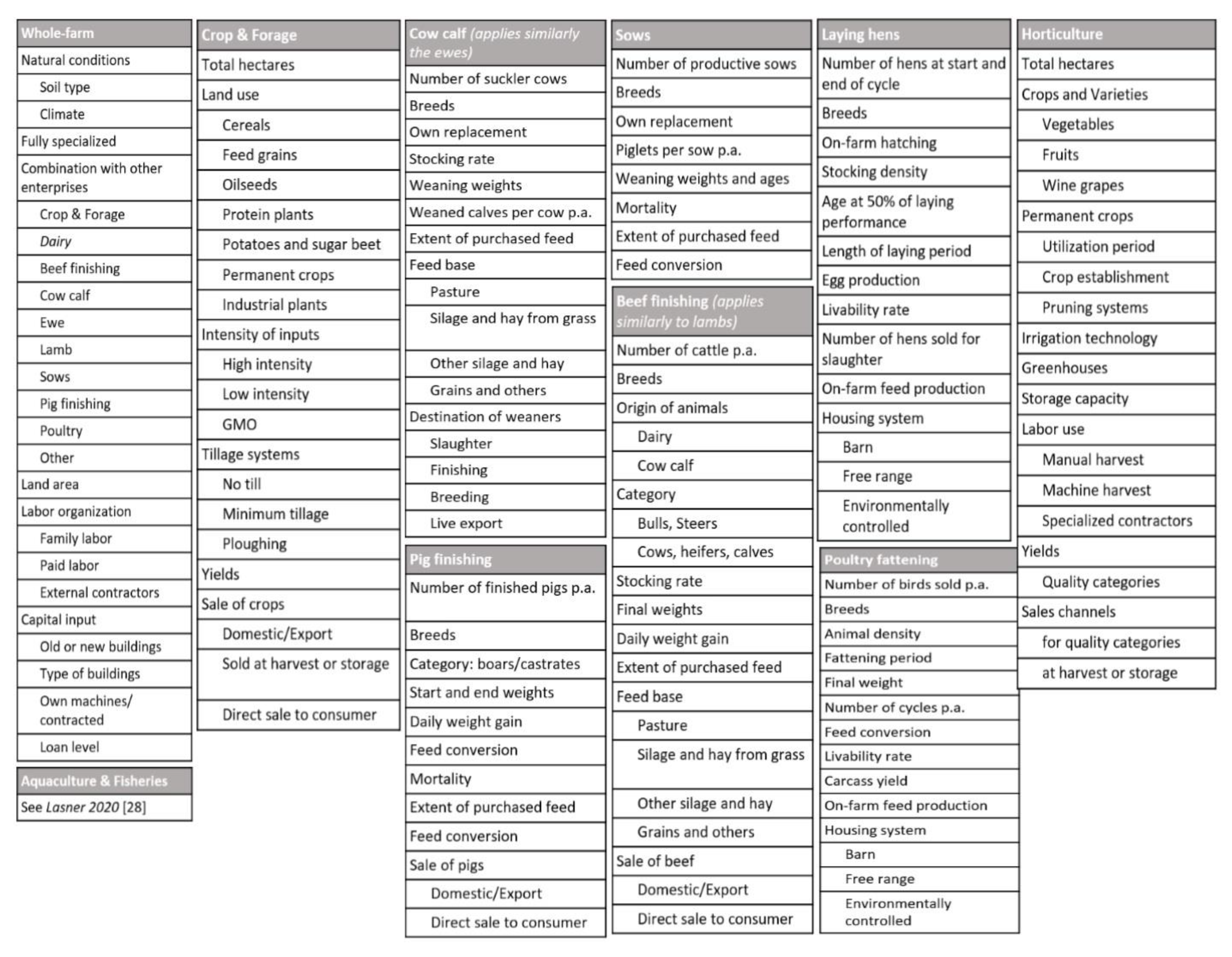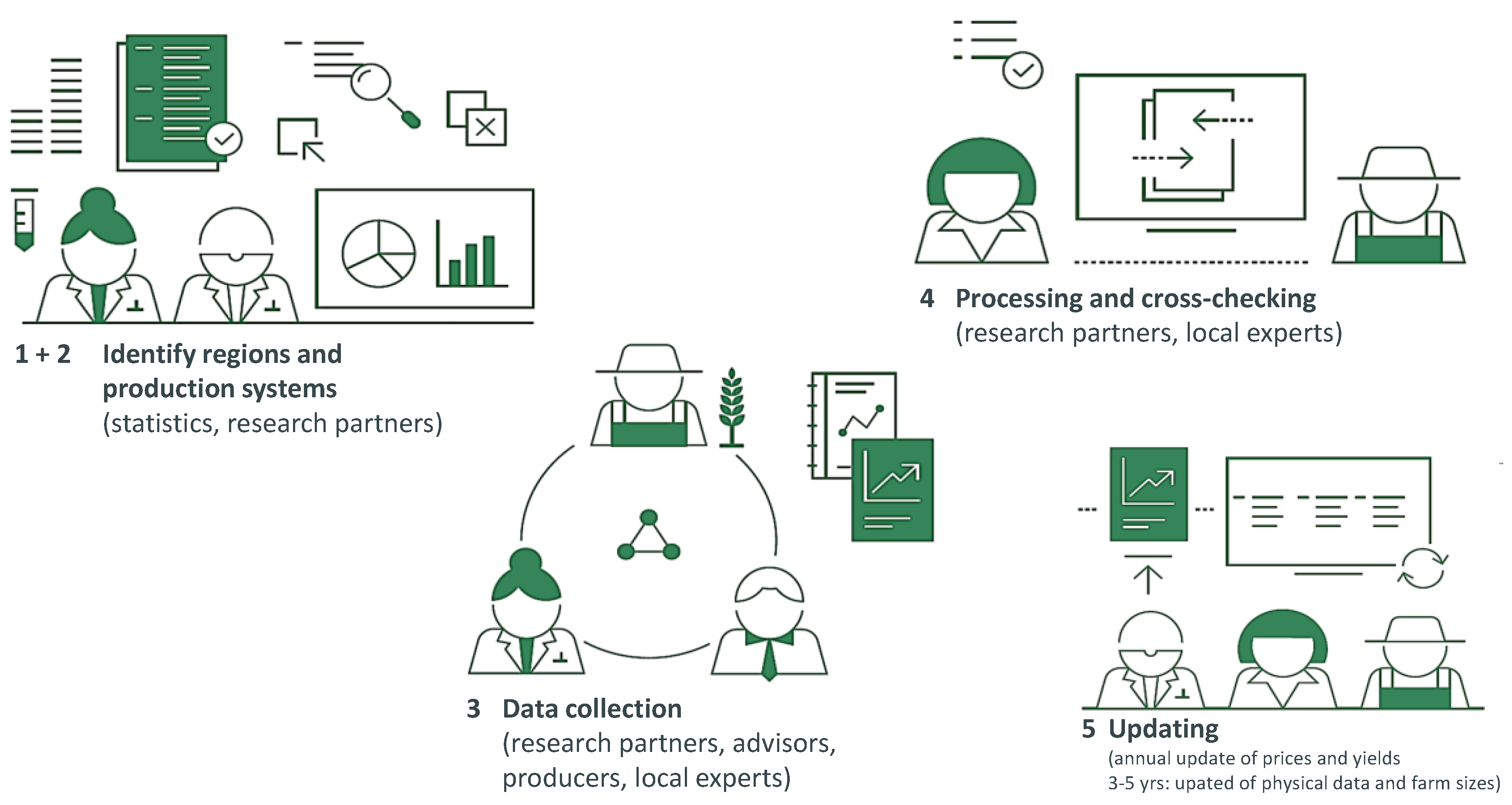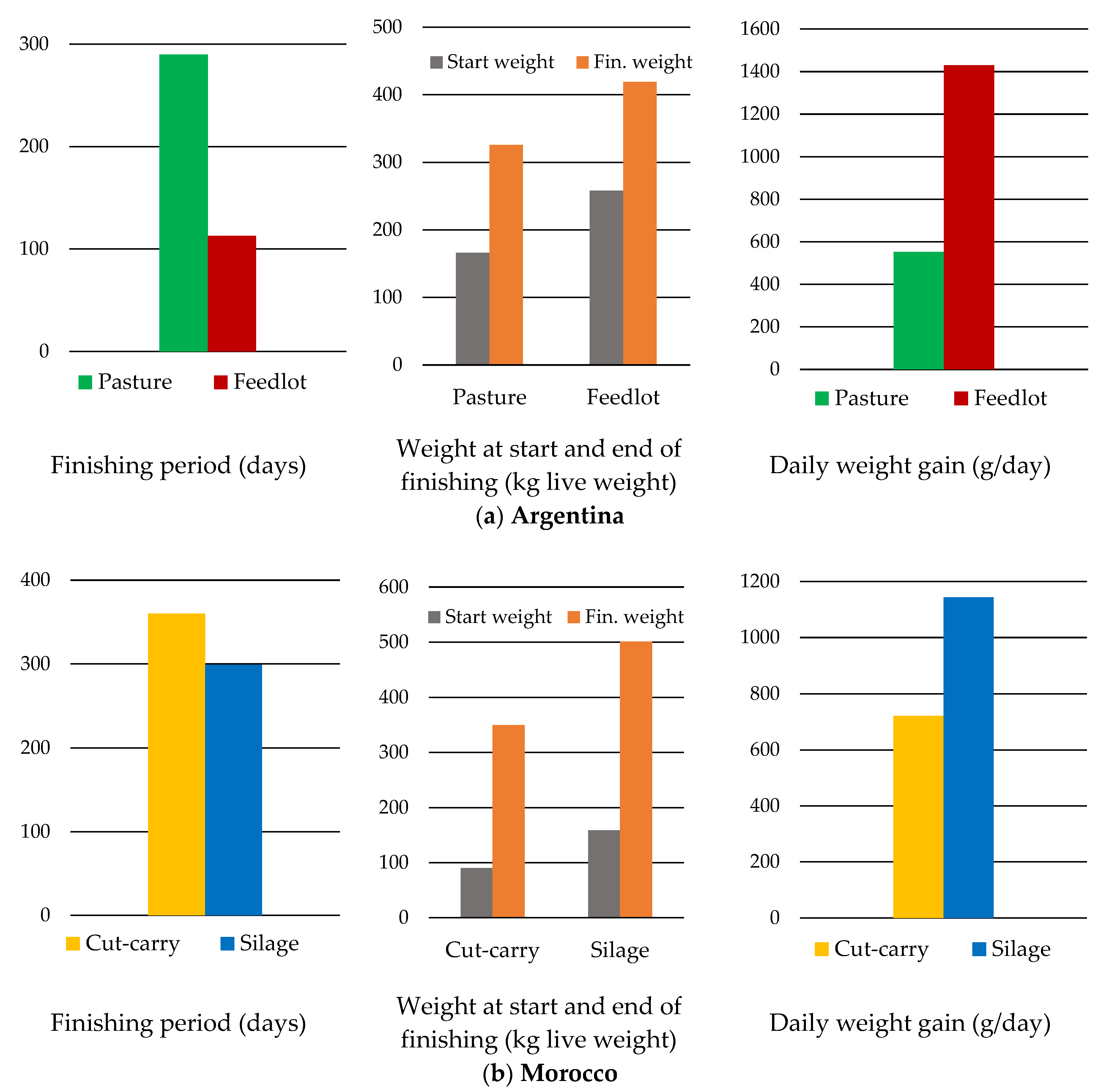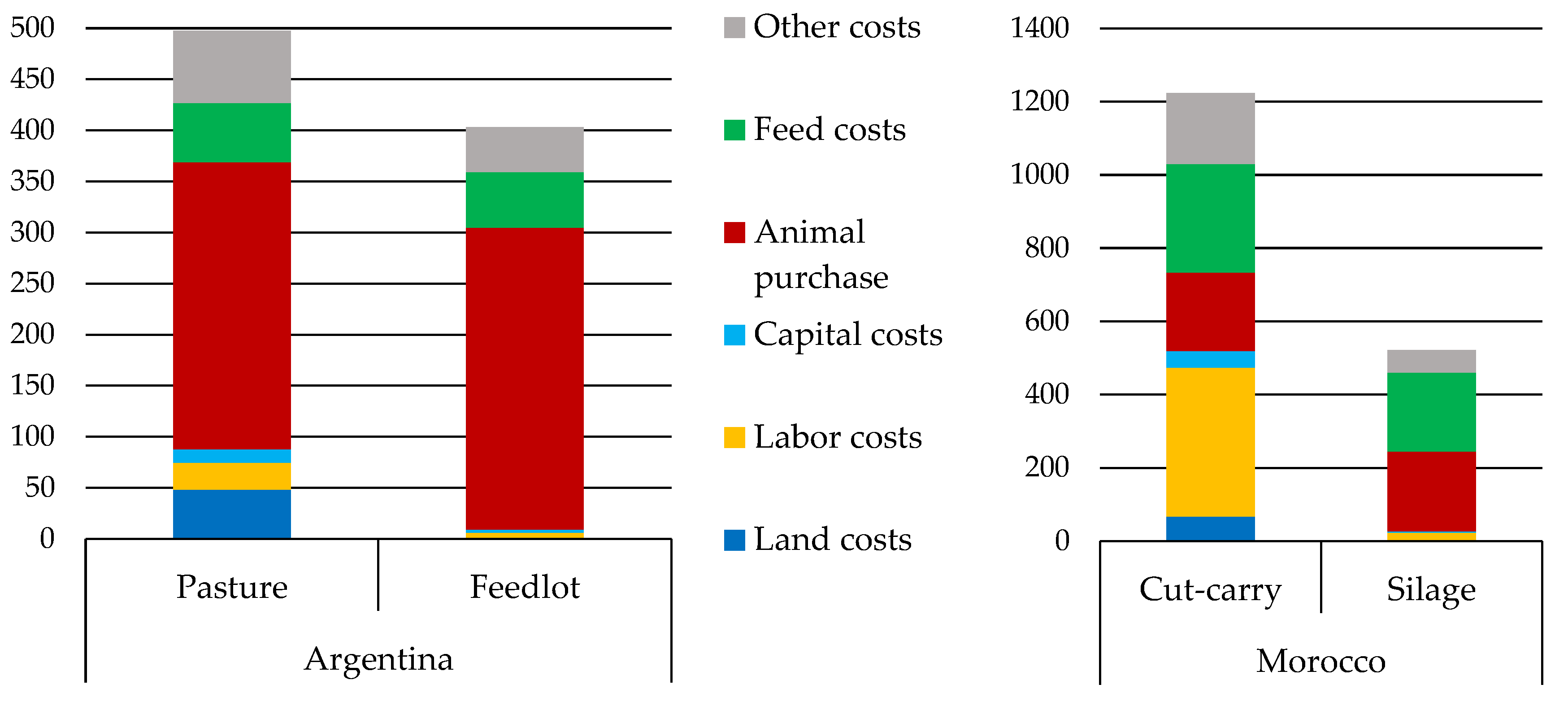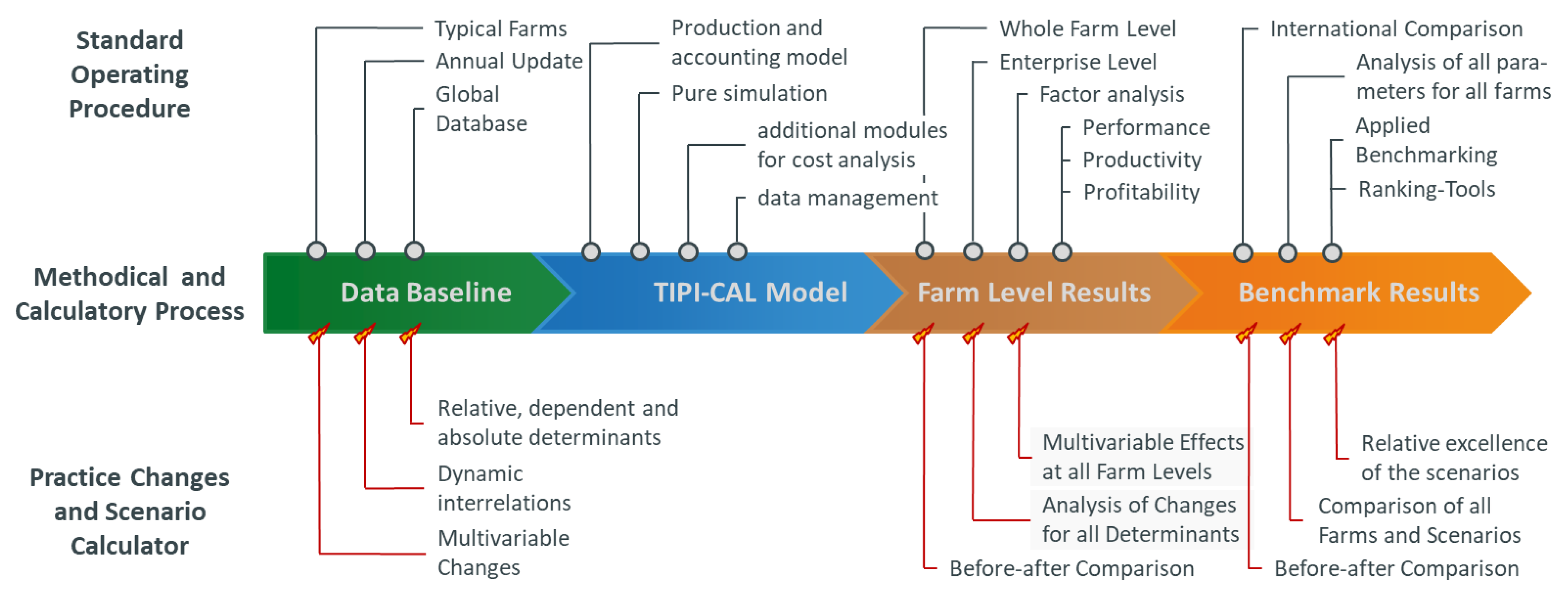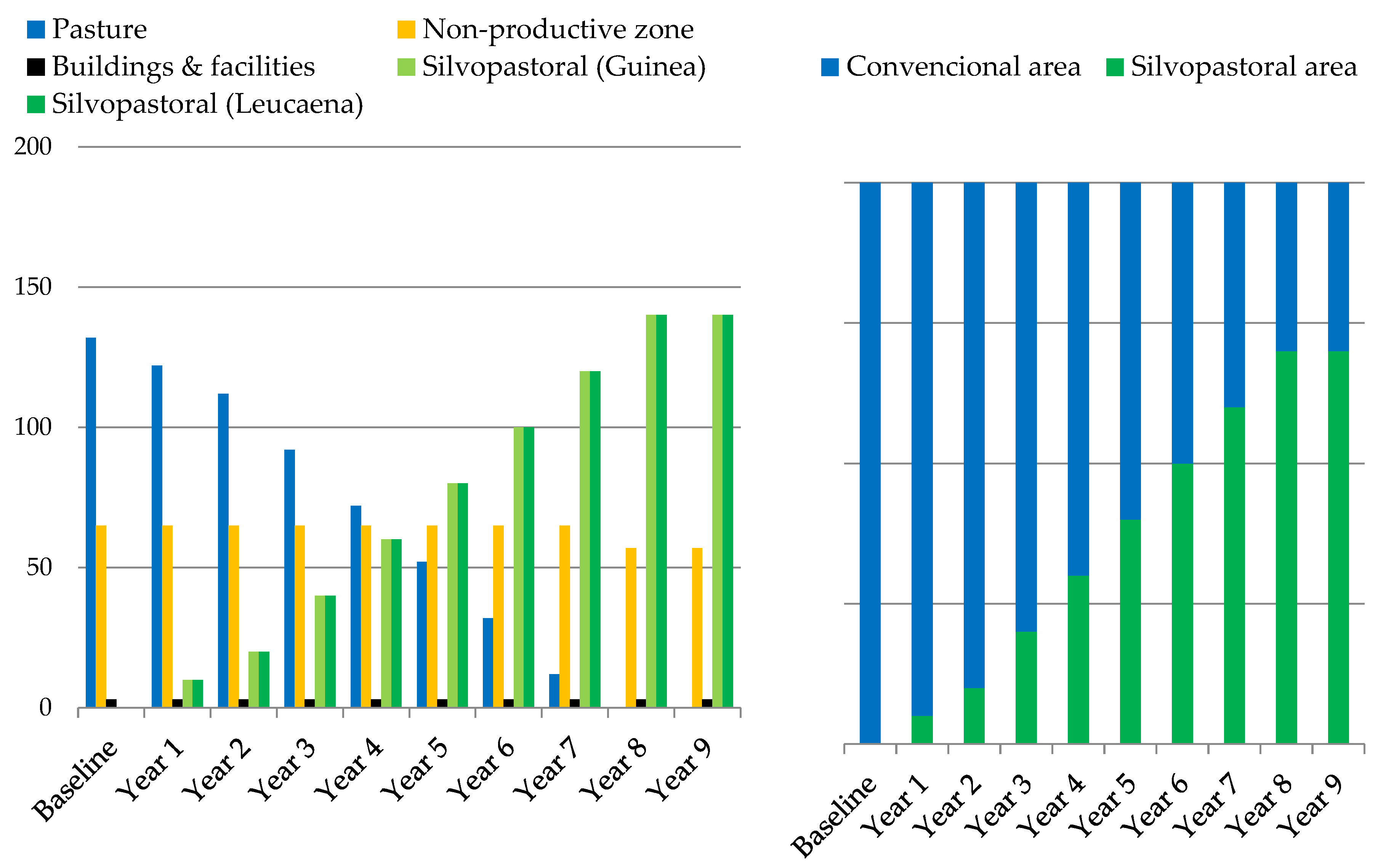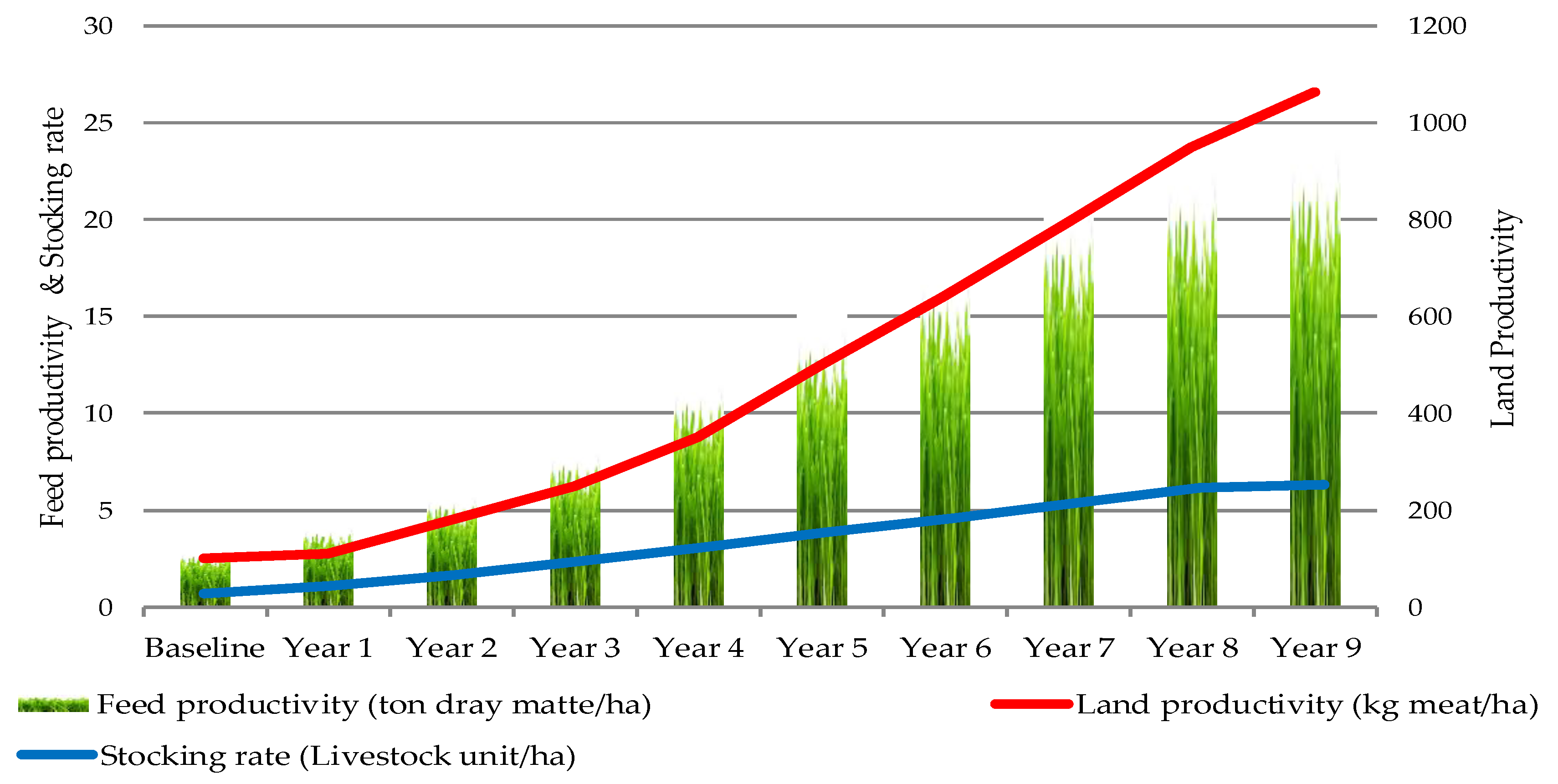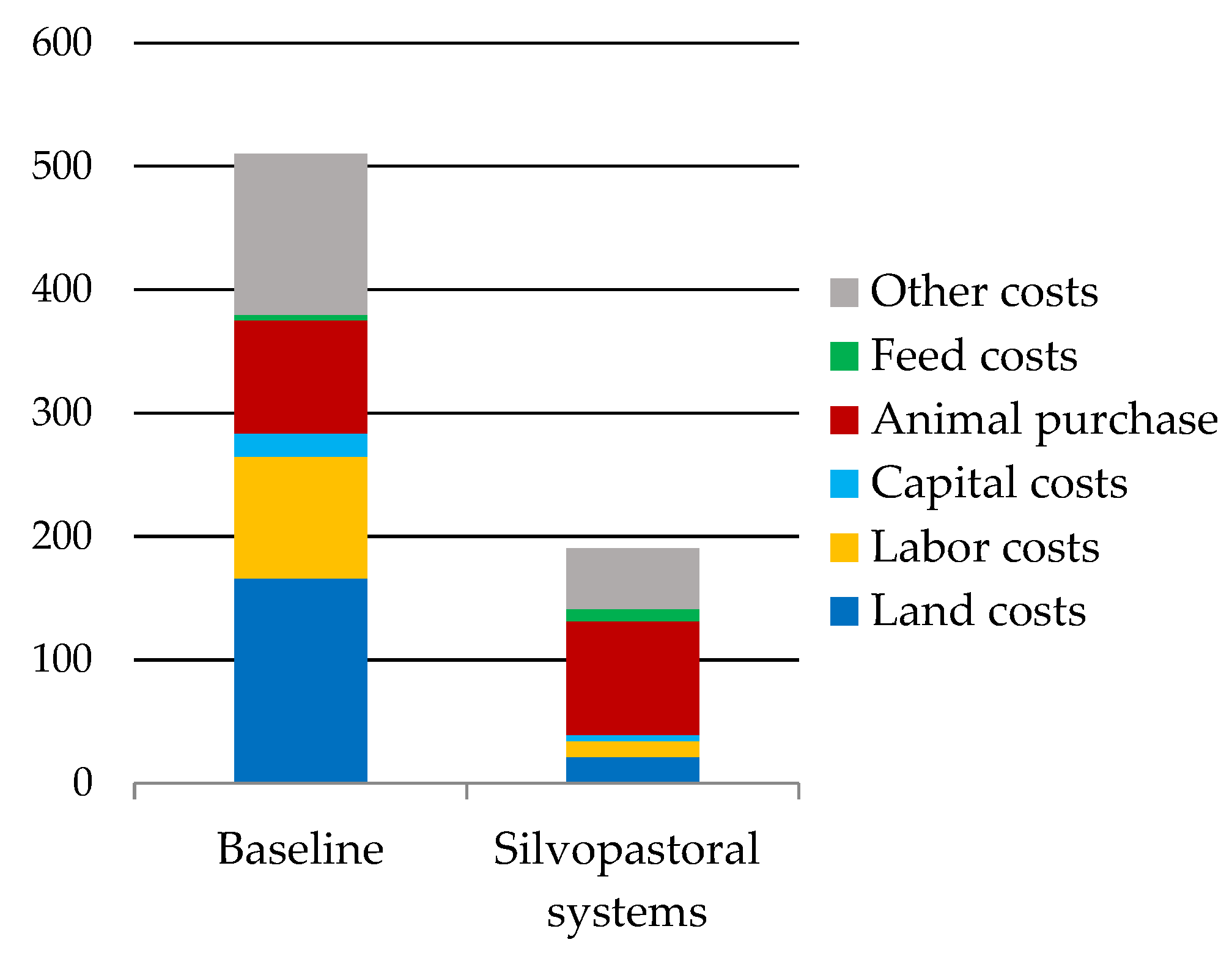3.1. Standard Operational Procedure (SOP)
The definition of typical farms follows several steps. These steps are intended to be identical in all countries and throughout all branches. The SOP describes in detail what each step entails. All steps of the SOP are performed jointly with research partners in the participating countries. These partners are members of the agri benchmark partner institutions. The main criteria for selecting partner institutions and individuals is not a certain institutional setting but (a) the knowledge of production systems and their economics, (b) the access to producers and (c) English skills. Partner institutions are mostly universities, research institutions, producer organizations, marketing organizations and agribusinesses. The agri benchmark Network classifies its partners into research partners, supporting partners and institutional partners.
Research partners provide sector data, farm data and management information which is used to construct and update typical farms. In return, partners receive information regarding the performance (productivity, costs of production and profitability) of their farm types or production systems, amended by the sectoral information from each country as well as global information on production and trade. Furthermore, the agri benchmark Network provides students from participating institutions the opportunity to write an undergraduate, Master’s or PhD thesis at the Thünen Institute.
Supporting partners are typically agribusinesses who substitute data contributions by funding, and in some cases, provide data and information to the Network, too. In return, they receive the same outputs as the research partners and are offered preferential access to the annual agri benchmark conferences.
Finally, the
agri benchmark Network also collaborates with international and multi-governmental organizations such as the Food and Agriculture Organization of the United Nations (FAO) and the International Meat Secretariat (IMS). These institutions support the idea of
agri benchmark and acknowledge its benefits, but they are not making regular contributions. An example of such collaborations was the nomination of the
agri benchmark Network by the FAO to chair the focus area on ‘Closing the efficiency gap’ of the Global Agenda for Sustainable Livestock. The five key steps of the SOP are described below and summarized in
Figure 1.
3.1.1. Step 1: Identifying Relevant Regions
This step entails the identification of the most important regions according to the purpose of the analysis. Thus, for the analysis of cost of production and competitiveness, the focus is on regional hot spots in terms of agricultural production in each country. In the vast majority of the countries, statistics can be used to perform this step. The main criteria for the selection of regions for broad acre crops, horticulture and specialty crops are total acreage of the considered crop in the region, proportion of the considered crop in cropland area of the region, and total production of the considered crop in the region (via yield per hectare). For livestock, the main indicators are the total animal numbers per region, and animal numbers per ha agricultural land (density). In contrast to cropping activities, for meat producing animals, total regional production can be a misleading indicator as live animal production and their slaughter/processing are often dislocated from each other, especially in large countries where slaughter occurs close to consumption centers and animal rearing and feeding takes place in more remote areas. In fisheries, fish production is not as controllable as livestock production for farmers or fish farmers. The annual catch is highly dynamic, does not provide a stable indicator and nor does the fishing area. Here, the size of the vessel (and machine power) indicates the potential of maximum productivity.
3.1.2. Step 2: Identifying Typical Production Systems
While this paper refers to the term ‘typical’, other expressions for typical could be ‘prevailing’, ‘representative’, ‘most frequent’ or ‘most common’. All of these expressions point at representing a significant share of national production that the
agri benchmark Network is aiming for. The identification of typical production systems is conducted in close collaboration with local experts who are usually farm advisors, producer organizations or research institutions with close contacts to producers. The main reason for this expert-based approach is the general lack of economic statistics about production systems and their prevalence in most agricultural statistics.
Figure A1 (in
Appendix A) provides an overview of the descriptors and indicators to characterize the typical farms and production systems on whole-farm level and enterprise level.
3.1.3. Step 3: Data Collection
After the identification of typical farms or production systems, the data collection can be done in two ways. The first and preferred way is to conduct focus groups consisting of the research partner, at least one local expert (advisor) and four to six producers. The producers’ farms should come close to the characteristics of the farm identified in Step 2. A standard questionnaire is used and filled-in jointly with the focus group members, using the farm type and production system identified in Step 2 as a basis. The research partners act as moderators and direct the discussion around the typical farming situation in a typical year. The discussion aims at achieving a consensus for each figure, taking out extreme figures or particularities of the individual producers. Instead of calculating an average of the participating producers’ farms, the most frequent or prevailing specification for each variable and indicator is recorded. The second way is to collect the data from an individual producer that comes very close to the typical farm identified in Step 2 and then ‘typify’ this data by replacing the farm particularities by more typical information and data available from expert knowledge, surveys and technical handbooks.
In both cases, consistent datasets are obtained. For the standard annual analysis of production systems, their cost of production and profitability, the second way proved to be sufficient and appropriate. Further, the organizational effort of the individual farm approach is obviously less than organizing and conducting a focus group. However, the latter provides a broader and better-grounded basis of the data. The focus group approach is essential when it comes to the analysis of adaption and adjustments of farms to changing framework conditions like price regimes, new policies and shocks like the COVID 19 pandemic.
3.1.4. Step 4: Processing and Cross-Checking
The Technology Impact Policy Impact Calculations (TIPI-CAL) model is used for data analysis. TIPI-CAL is a production and accounting model that enables the calculation of physical (cropping pattern, yields, inputs, animal performance, land use, labor, machinery, equipment, buildings) and economic parameters (prices, financing, overhead costs, variable costs). In recent years, some environmental indicators have been added, for example to calculate greenhouse gas (GHG) emission. The model produces a whole-farm profit and loss account, a balance sheet and a cash flow. At the enterprise-level, a total cost calculation is produced (including cash costs, depreciation and opportunity costs). In an ‘interplay’ procedure, results are reverted to the data providers. Changes in the data are made until an agreement is achieved that the data set is realistic, accurate and consistent.
3.1.5. Step 5: Updating
The updating of the data takes place annually for all prices and in the case of cash crop and horticulture, for yields, too. Updates are either done for each farm individually or through national or regional projection data which are applied to the farms in a country. Every three to five years and where relevant, updates of the farm sizes (hectares, animal numbers), performance indicators and their organization (labor, capital) are carried out. All these steps are performed jointly with the research partners and the local experts in the countries.
3.2. Branch-Related Specifics
The agri benchmark Network applies the typical farm approach in various branches which include beef, sheep, pig, poultry, cash crops, horticulture as well as aquaculture and fisheries. This section highlights the particularities of the application of the SOP in these branches.
3.2.1. Beef
The
agri benchmark Beef Network was established in 2002. The network is composed of 48 institutional partners from 34 countries across Africa, Asia, Europe, North America, South America, South Pacific and the Middle East. The beef branch includes cow-calf operations and beef finishing operations. To date, the network has 139 typical beef farms that represent different production systems from across the world. Of which, 67 farms are beef-specialized, 33 farms are cow-calf, and 72 farms are operating both cow-calf and beef finishing. In the typical farm approach, the cow-calf enterprise starts with the birth of the calf and ends with the day of weaning. The beef finishing business starts when dairy or weaner calves or feeder cattle are bought from outside the farm or transferred from the dairy or cow-calf enterprise to the beef finishing enterprise in the same farm. Beef production globally deals with a considerable variability of production environments. Those define the production factors’ availability and costs. With cow-calf production predominantly based on pasture and grazing, housing systems represent a significant difference for cost comparisons across systems. Thus, in the cow-calf production stage the
agri benchmark Network distinguishes between “winter barn” and “outdoor” systems. In the finishing production stage, the differentiation is made based on the feed ratio composition, as feed represents a crucial cost factor. The
agri benchmark Network distinguishes between “pasture-based”, “silage-based”, “grain-finished” and “cut and carry” production systems [
29].
When there is a high variability of production systems within one country that impact farm cost structure, it is advisable to cover this variability with the establishment of typical farms. Besides the beef production systems, the origins and disaggregation of beef production impact the data analysis. The origins of beef animals affect their value, starting weight and starting age. Generally, three origins of beef cattle can be differentiated: dairy production, where male calves are generally sold off for meat production shortly after birth, cow-calf systems, where the majority of weaners are sold off for meat production at the age of weaning, and dual-purpose systems, where milk and weaners are coproducts. The level of disaggregation of the beef production needs to be considered to conclude on performance and productivity indicators across countries and production regions within one country. A separation of the production stages “backgrounding” and “finishing” is common in beef producing countries. To analyze the entire production cycle, a reflection of all relevant production stages in the typical farm identification and definition is recommended. A seamless integration should be reflected, if this requires the collection of different typical farms, e.g., concerning the age and weight of animals leaving one and entering the subsequent system.
The beef branch, as well as the other livestock branches (especially sheep and pig), deals with two specifics when it comes to overhead farm costs and own forage/feed production.
To compare the typical farms globally, the costs and returns must be assigned to the different enterprises. An approach of cost and return allocations is conducted in two steps. (1) Whole-farm level costs and returns must be allocated to the enterprises like forage, beef finishing and cow-calf. This mainly applies to costs like machines and buildings, hired and family labor, own and rented land as well as overhead costs such as insurances. If a direct allocation by specific use (e.g., feeding equipment) or working hours (e.g., farm worker) is not possible, the items (e.g., manager salary) are allocated by the enterprise’s share in returns. (2) Further costs, such as the variable costs per animal, and returns are allocated to different groups of animals within the enterprises (finishing groups, calving periods) which usually have different resource and input requirements. If data availability does not allow this level of detail, allocation from enterprise level to the groups is done on a return share or weight basis.
In mixed farms or grazing livestock systems, forage production can represent a substantial part of farm resource allocation and costs. Due to the fact that in many countries no markets and associated prices for grazing and forages are available, the on-farm-produced feed and forage is reflected in terms of their calculated cost of production. Thus, the principle of opportunity costs from selling and buying at market prices is not considered here. However, purchased feed components are quantified in quantity and price per tonne and added in the total feed costs.
3.2.2. Sheep
The agri benchmark Sheep Network was established in 2010. The network has 30 institutional partners from 16 countries. To date, the network has constructed 40 typical sheep farms that represent different production systems in the participating countries. Similar to beef production, sheep farms are confronted with very different production conditions worldwide. Depending on the regional availability or scarcity of production factors, different production systems are applied and different herd management strategies are used, which can lead to very different costs of production. Therefore, the agri benchmark Network defines four different production systems according to the feed rations employed on the farms (1. grazing systems, 2. forage systems, 3. grazing and forage systems and grains, 4. concentrates and forage systems). In addition to the feeding systems, the strategy for herd management is also reflected in production costs.
To consider the different strategies in herd management and reflect in the farm data, different indicators are collected. Those can be recorded for two different flocks per farm, allowing a more precise description of the production method. A distinction is made between seasonal and aseasonal lambing, whereby it can be specified what proportion of the ewes are lambing in which period. Additionally, the average date of lambing during the year, the length of the weaning period and the post-weaning time are recorded. Besides production characteristics, marketing aspects play a crucial role for the economic results. Thus, the destination of the produced animals represents another important characteristic of the farms. For each animal group (breeding rams, ewes, young ewes, male/female lambs) the share of animals sold to the different destinations (culled, sold for breeding, going to finishing, sold/ transferred as stores, sold for slaughter at weaning, sold for slaughter later) is specified. This animal flow also defines which replacement strategy is pursued by breeding farms. Lambs finished under the ewes and later after a short finishing period are accounted for in the ewe enterprise. In a few cases the finishing of lambs takes place separated from the ewe husbandry or lambs are bought from outside the farm just for finishing. If so, the lamb finishing can be analyzed as an independent operation, similar to the beef finishing operation. In addition to the selling of animals, in some countries wool production accounts for an important share of returns. In these cases, the wool yield and quality are also recorded.
3.2.3. Pig
The agri benchmark Pig Network was relaunched in 2015 and has partners from 19 countries. The countries represented in the network include major pork producing countries like China, the United States of America (USA), Germany, Spain, Vietnam, Brazil, Russia and Canada. To date, the Network has established 61 typical pig farms that represent different production systems from across the world. Global production systems in pig production show a high variability regarding their degree of specialization and integration. In order to pre-define a typical farm(s) in pig production in a country and the selected region, these two major concepts need to be outlined.
To define the degree of specialization, the prevailing combination of farm enterprises (specialized sow or pig finishing farm or mixed system) need to be described. Mixed systems might include a combination of specialized sow farm and cash crop production, a combination of sow and pig finishing farm, called a closed system [
25], or a combination of a specialized pig finishing farm and other livestock enterprises. In the typical farm approach, the sow enterprise starts with the birth of the piglets and ends with the day of weaning. This can be a weaned piglet, which usually has a live weight of 6–8 kg, or a reared piglet, which usually weighs between 20–30 kg. The pig finishing enterprise starts when weaned or reared piglets are bought from outside the farm or like in closed systems where piglets are transferred from the sow to the pig finishing enterprise and normally moved to a special fattening barn. The weaning/rearing weights of the sow enterprise correspond to the start weights of the finishing enterprise [
30].
The degree of integration differentiates between a single owner operation and a vertically integrated farm [
25]. Integrated farms are characterized by two agents: ‘the integrator’, who is usually an upstream or downstream company like breeding companies or slaughterhouses, and ‘the integrated’, who is usually a pig farmer [
31]. Data availability is mostly more restricted in integrated farms as well as in countries with big industrial companies dominating the production, such as in China, Russia and the US, than in single owner operations.
Other criteria for the classification are the productivity in terms of physical productivity (high or low), the share of purchased feed on the farm and whether the farm labor is supplied by family or hired labor. Based on this pre-definition process, we identify the characteristics of the typical farm/production system [
25] based on the indicators shown in
Figure A1 (in
Appendix A).
3.2.4. Poultry
To date, three typical broiler farms have been constructed for Ghana, one typical broiler farm for Germany and six typical farm constellations for Germany. Within the context of the agri benchmark Network, the poultry branch currently focuses on economic analysis of broiler, layer (egg) and turkey production. The typical farm approach can also be applied in farm economic analysis of other poultry species such as ducks, guinea fowl, geese, quail and ostriches.
Similar to other branches, the poultry branch uses focus groups to construct typical farms. However, if highly vertically integrated production systems with standardized production processes and a high degree of sectoral concentration are prevailing, as in West European countries, data availability is mostly more restricted. Therefore, the individual farm approach is used instead of focus groups. Typical poultry production systems can be identified based on the level of vertical integration of operations, housing system, farm size, production intensity in terms of level of production density and input use, outdoor access, animal welfare measures and marketing systems. These production systems include the integrated large-scale, medium-scale and small-scale production systems. Positive agglomeration and cluster effects often lead to a regional concentration of land independent poultry production [
32]. The increasing structural change is leading to fewer and larger entities keeping poultry in several production sites in a region.
In terms of data analysis, unlike with other branches, the feed costs include the costs of purchasing the feed ingredients and preparation of the feed (milling). Similar to the pig branch, poultry production has several cycles in a year. Therefore, calculations in the TIPI-CAL model are adjusted to account for the several production cycles in a year.
3.2.5. Cash Crops Sop
The agri benchmark Cash Crop Network was established in 2006. The Network has institutional partners from 40 countries across Africa, Asia, Europe, the Americas, and Australia. To date, the cash crop Network has established 120 typical farms and is analyzing the economics of all major broad acre crops, including corn, wheat, rice, soybeans and sunflower, and perennial crops such as sugar cane or palm oil.
With regard to cost allocation there is one major difference between the livestock- and the crop-related (both arable crops as well as horticulture) approaches. While the livestock branches (especially beef, sheep and pig) use return shares for the allocation of fixed and overhead cost to individual enterprises and products, crop and horticulture use machine run times to allocate machinery and labor cost to individual crops. The logic is that crops that are more demanding in the use of these resources are supposed to carry a higher share of the total cost than low-care crops. The basis for this allocation concept is the documentation of all major operations in crop production including data on machinery used, productivity of machine use, number of workers involved, amount of fertilizers or seeds applied per operation; cost of crop protection products applied per operation, working depth in tillage and fuel use per hectare. In case there is just manual labor involved and/or a combination with draft animals, the same concept is applied.
Furthermore, some cropping systems and crops require specific additional analyses and approaches. For crops that have low or no value when raw, such as sugarcane and cassava, the cash crop branch expands the data analysis beyond the farm gate to include the economics on the processing stage. Perennial crops, such as sugarcane or palm oil, require a specific approach to the accountancy of establishment costs. The agri benchmark Cash Crop Network considers the fact that crop establishment is an investment that is only made once and a number of subsequent harvesting periods capitalize on this investment and reflect it in the data. The Network also captures the specifics of double cropping systems, i.e., systems which allow for two or even three crops per year, that are widespread in Latin-America and found in Asian rice production. The main challenge here is to allocate annual land rents to these crops.
Last but not least, the issue of multi-annual fertilization strategies needs to be reflected. This is a very relevant feature in most cropping systems when it comes to the fertilization of Phosphate, Potash and Calcium. Since 2020, the Network applies an algorithm to allocate respective costs to those crops that benefit from this fertilization, even though the actual fertilization takes place in another crop.
3.2.6. Horticulture
The agri benchmark Horticulture Network was established in 2012 and has partners from 11 countries. To date, the network has established 19 typical farms (apples and wine grapes) that represent different production systems found in the participating countries. Horticulture or specialty crops include a very large range of production systems of vegetables, fruits, flowers and ornamentals. Necessarily, a benchmarking effort has to focus on specific products. The approach in the horticulture branch therefore is to focus on crops that are of major importance in terms of global production and trade, such as apples and wine grapes. Other specialty crop production systems, e.g., vegetables or other types of fruits can also be included according to partner interest. As these production systems are highly intensive in terms of labor and input use and require very specific know-how, equipment and marketing infrastructure, the farms targeted according to step 1 of the SOP are often specialized in one single crop. Detailed data collection includes only the target crop. If the typical farm has more enterprises, net revenues are included as an overall estimation, and the costs of machinery and farm equipment is assigned to the crops according to respective usage share for the different enterprises (e.g., x% of tractor and pesticide sprayer, but 100 % of the grape harvesting machine are assigned to grape production).
The quality of the output is a major factor for production system design. For a meaningful comparison of the competitiveness of fruit or wine grape production, it thus needs to refer to similar target markets, e.g., typical farms producing fresh apples as table fruit or wine grapes for quality bulk wine.
Specific challenges for data collection arise from the high level of input and labor use and large yield variations. Where manual harvest is common and yields are highly variable depending on weather conditions (e.g., late frost, hail), focus groups should agree on estimates of harvesting labor productivity per yield unit, so labor input can be adjusted according to yield levels in specific years. While labor usually represents a major share of costs, expenses for inputs such as pesticides or fertilizers are less important. With highly individual plant protection strategies for each farmer, focus groups may be able to agree on a realistic average lumpsum for pesticide costs per year rather than on a typical spraying scheme.
An important cost factor is the cost for orchard establishment and years to first full harvest. These costs for permanent crops are included as share of acreage in establishment or full harvest, based on the average utilization period of the orchard.
3.2.7. Aquaculture and Fisheries
The typical farm approach was applied in aquaculture and fisheries for the first time in 2014 [
19]. The
agri benchmark Fish Network is composed of partners from 10 countries which include Austria, Denmark, Germany, Norway, Poland, Republic of Ireland, Spain, Turkey, United Kingdom and Vietnam. This section is an extract of a more comprehensive paper “Being Typical—The Representative Farms Method in Aquaculture and Fisheries”, which was published in Mediterranean Fisheries and Aquaculture Research 3(2) [
33].
In the context of aquaculture and fisheries, the typical farm approach utilizes a dataset from a farm or vessel with stable characteristics, earning adequate profit, adequately equipped, and which represents a group of similar units using a common production method in the same region [
19,
20]. The modal concept relies on diverse sources for pre-defining the example, but the pertinent characteristics are then verified empirically. In aquaculture and fisheries, the typical farm approach comprises three main interactive stages: abductive pre-definition of representative farms, inductive definition, and an abductive-inductive plausibility check. The pre-definition stage is based on knowledge available from the literature and statistics. According to step 2 of the SOP, the identified sector or market must be clearly framed, for example as traditional pond systems producing portion-sized rainbow trout for human consumption in Germany. This framing will later delimit what can be represented by the model. An important region for the type of production being evaluated is then selected either for its share of national production and/or for its share in the total number of farms. In some cases, niche markets (e.g., organic farms) or future-looking production systems (e.g., recirculated aquaculture systems (RAS)) might be included in a model as archetypes of good practice.
In the second stage, fish farmers (or skippers in the case of fishery vessels) and consultants from the selected production region are contacted and invited to form a focus group of up to 12 participants whose role is to define a representative farm, step by step. A researcher instigates and moderates discussions about the value of cost variables, input volumes, outputs and prices. The exact number of variable values to be defined depends on the production system, but the list includes at least 22 of the economic variables of the EU Data Collection Framework (DCF): Turnover, subsidies, other income, total income, wages and salaries, value of unpaid labour, energy costs, stocking costs, feed costs, repair and maintenance, other operational costs, depreciation of capital, financial costs, extraordinary costs, total value of assets, net investments, debt, sales volume, stocking volume, feed volume, number of employees, full-time labour equivalent (FTE). Experience suggests that annual production volume is the best starting point (e.g., 25 tonnes of portion-sized brook trout as main species) for aquaculture systems and vessel type (including machine power and vessel size as indicators) is a good starting point for modelling fisheries’ vessels. Often the value of one variable is automatically linked to that of another: for example, if the typical farm produces 25 t brook trout with a final harvest weight of 400 g per fish, it needs around 70,000 fingerlings at 10 g per piece, assuming a typical mortality of 10 % per production cycle. By working through these variables, a coherent picture of the typical farm is built up through consensus within the focus group. Simultaneously, and in contrast to statistical averaging, the defined variables control each other—for example Feed Conversion Rate (FCR) should meet the volume of fish feed used and the feed costs should be in line with feed volume and feed price etc. Finally, the modelled typical farm can be validated by real world fish farmers (or skippers) in accordance with their lived experience and by researchers, so that existing knowledge may be modified.
